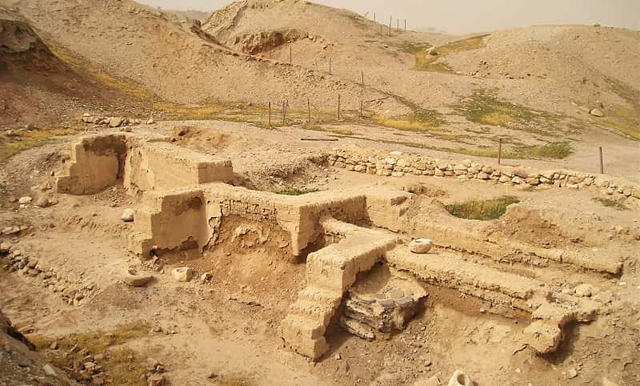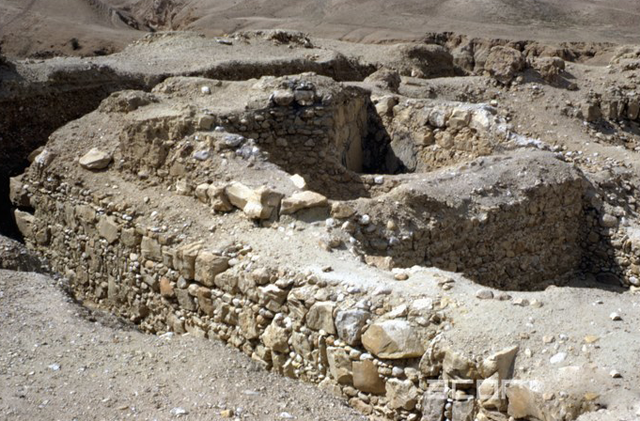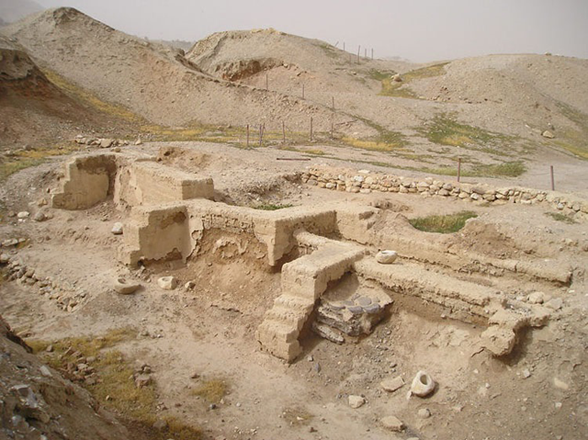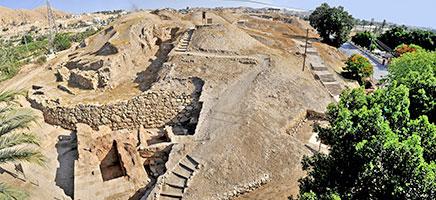You are here
Discoveries in Jericho: dagger of Tell Sultan
By Saeb Rawashdeh - Sep 12,2024 - Last updated at Sep 12,2024

A building in Jericho dating from the Early Bronze IIIB (circa 2,450-2,350 BC) was excavated and restored in year 1997-1999 (Photo of Madain project)
AMMAN — The archaeological team found a dagger in a necropolis north of Tell Sultan thanks to a villager who gave it to the Italian-Palestinian archaeological expedition to Tell Sultan. The finding spot (and presumably the location of the tomb which contained the dagger) is Area A of Early and Middle Bronze Ages necropolis of Jericho.
"The weapon is a fragmentary short dagger, attributable to the group of the Early Bronze IV simple type well-known at the site in funerary repertoires and it dates back to the Early Bronze IVA [2,350- 2,200 BC], according to the archaeological periodisation established by the Italian Palestinian Expedition on the ground of stratigraphy and connected to radiocarbon dates," said the professor of Near Eastern Archaeology Lorenzo Nigro from Sapienza University of Rome.
The dagger is damaged on the tang edge and the tip is broken. Four rivets originally were placed on two rows in the tang, as it is still recognisable even though the weapon surface is corroded.
In the lower row one rivet hole is visible, and the other one is partially detectable in the fractured section; in the upper row, the first rivet hole is placed 1.3 cm above the other preserved in the lower row, and a second one is symmetrically placed on the opposite end, above the broken part, Nigro continued, adding that the cross-section is thin and flattened along its overall length.
"The tang has a nearly trapezoidal shape showing the maximum width just in front of the upper row of rivets. Holes for rivets, occluded by corrosion products, had a circular shape, as like it is attested in other specimens, to accommodate them which usually have a quadrangular cross-section," Nigro stressed, noting that it was produced with a bi-valve mould and refined by cold-working and annealing, as also observed in other specimens from Tell es-Sultan.
In Southern Levant, daggers appear in funerary equipment since the beginning of the Early Bronze Age (3400-2000 BC), made of copper and, in the later stage, of alloyed copper, namely arsenical copper and tin-bronze. Daggers are a close-range weapons, characterised by the length of the blade, up to 18 cm in the case of short daggers, and from 20 cm up to 30 cm for the regular type.
A further feature used for classification is the shape of the tang or of the stick which allowed to fix the handle to the blade, he said, noting that it could be simple, developed, or peduncolar.
Furthermore, "In the Southern Levantine archaeological record, this class began to appear since the initial phase of the Early Bronze Age, primarily in funerary contexts. In the Early Bronze I-III, daggers were made mainly of copper, or of arsenical copper [with a low arsenic content]. During the Early Bronze IV, they were made mainly of arsenical copper with a ratio of arsenic generally encompassed between 1.5 per cent and per alloy was first experimented," Nigro highlighted.
Daggers collected in the necropolis of Tell Sultan may illustrate in a very clear way the simple type of short and long daggers to which it belongs. The tang can be either rounded or quadrangular, wearing in most cases four rivets placed on two rows; in a few cases rivets could be three, arranged in a triangle, or six on three rows, the professor explained, adding that some blades present midribs.
Specimens found in the Jericho necropolis were basically made of copper and arsenical copper, just three made of tin-bronze are known.
"Among arsenical copper items, two clusters can be detected according to the content of arsenic: one with an average percentage of arsenic at 2 per cent and another with average percentage of arsenic at 4 per cent," Nigro said.
The development of metallurgy in the Near East and Eastern Mediterranean occurred in 4th and 3rd millennium BC where centres like Anatolia, Cyprus and Wadi Faynan played their roles.
"Metals were present at Jericho since the Pre-Pottery Neolithic Period as several beads, pendants and artifacts made of 'greenstone' were retrieved in PPNA layers of Tell Sultan," said Nigro, adding that these “greenstones“ were the ore deposit of the Wadi Faynan.
Copper items were then distributed through the main urban centres like Arad, Jericho, Bab Dhra, Yarmoukh, Batrawy and Megiddo, by nomad traders.
"In the newborn cities small scale secondary melting was performed, in order to accomplish the needs of the centralised palatial economy. Jericho maintained its role of hub of metal importation and refining and trade," the scholar underlined, adding that finds such as drops, scraps, smelted ores and slags, however, are markers of secondary melting activities and recycling, and suggest that metallurgical production and casting processes took place in the areas all around the site.
Related Articles
AMMAN – The Levant represented the natural outlet for ancient Egypt which exercised its political dominance since 4th millennium BC.
AMMAN — In the Middle Bronze Age, Jericho became a city surrounded by thick walls and the spiring area was part of the fortification.
AMMAN — The transition in burial practice and rites during different phases of the Bronze Age intrigued researchers studying the ancient sit














